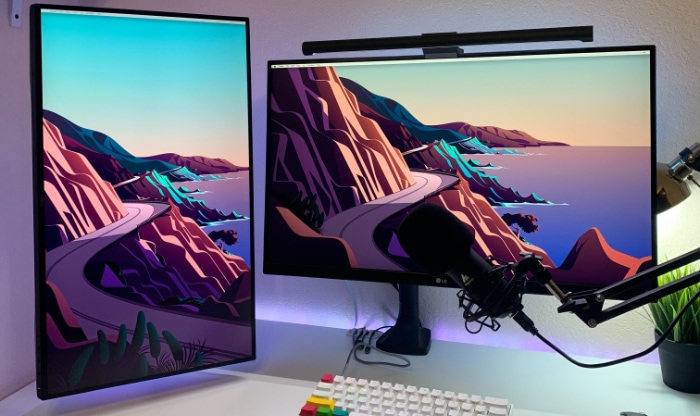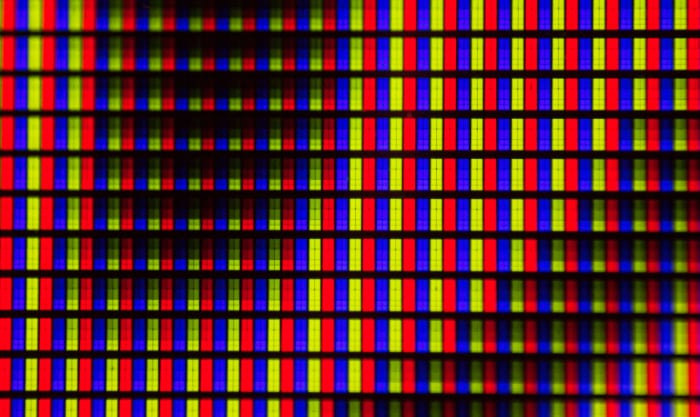TFT vs. IPS: Exploring Display Technologies

In the realm of digital devices, display technology plays a pivotal role. This element not only defines the quality of visuals but also influences our user experience in significant ways.
Whether it’s watching an ultra-high-definition movie on a large screen, editing a picture with meticulous attention to color accuracy, or engaging in a high-speed online gaming match, the quality of the display technology can make or break the experience.
Two prominent display technologies widely used in today’s world are Thin Film Transistor (TFT) and In-Plane Switching (IPS). These technologies, found in various devices, from smartphones to computer monitors, differ in their operation, capabilities, and ideal use cases.
By understanding the intricacies of TFT and IPS, you can make informed decisions when purchasing electronic devices, matching your specific needs with the most suitable display technology.
Understanding Display Technology
Display technology has come a long way since the inception of electronic devices. From the monochrome Cathode Ray Tube (CRT) displays of the early computers to the vibrant Liquid Crystal Displays (LCDs) of modern-day devices, the evolution of display technology has been a fascinating journey.
These advancements have not only improved the visual quality of our devices but also made them more energy-efficient and compact, contributing to the sleek designs of current electronic gadgets.
The Role of Display Technology in User Experience
Display technology significantly shapes the user experience. It determines the accuracy of color reproduction, the sharpness of images, the viewing angles, and the refresh rate of the screen, among other things.
For instance, a photographer would need a display with accurate color reproduction for photo editing, while a gamer would value a high refresh rate for a smooth gaming experience.
How Display Technology Works
At the heart of display technology is the pixel – the smallest unit of a digital image. A screen displays images by controlling the color and brightness of each pixel. Technologies like TFT and IPS differ in how they manipulate these pixels to display an image.
The Importance of Understanding Display Technologies
Understanding different display technologies can help you make informed decisions when buying a new device. It allows you to choose a device that best suits your specific needs – be it gaming, graphic design, or general multimedia consumption.
Moreover, as display technology continues to evolve, being familiar with the current standards will enable you to appreciate and navigate the future advancements in this field.
Introduction to Thin Film Transistor (TFT) Technology
Thin Film Transistor (TFT) technology is a variant of Liquid Crystal Display (LCD) technology that employs tiny transistors and capacitors to control the illumination of each pixel on the screen. As the name suggests, these transistors are thin films, and their implementation on a glass substrate forms the basis of a TFT display.
The Science Behind TFT – How it Works
Each pixel in a TFT display is associated with a thin film transistor. This transistor regulates the light passing through that pixel by controlling the electrical charge of the liquid crystals situated in front of the pixel.
When the transistor allows a charge to pass, the liquid crystals align in a way that lets the backlight of the screen shine through, illuminating the pixel. The intensity of this illumination depends on the degree of the charge applied, thus enabling different colors and brightness levels to be displayed.
Typical Uses of TFT Displays
TFT displays are used in a wide range of devices due to their versatility and cost-effectiveness. They are commonly found in televisions, computer monitors, laptops, and smartphones. With their ability to deliver decent image quality at an affordable price, TFT displays have become a popular choice in many consumer electronics.
Pros and Cons of Thin Film Transistor (TFT) Technology

TFT is a popular choice for many electronic devices due to its cost-effectiveness and adequate performance for general use. However, like any technology, it has its strengths and weaknesses.
Advantages of TFT Displays
Cost-effectiveness: TFT displays are typically less expensive to produce than other types of displays, such as IPS. This makes them a popular choice for budget-friendly devices.
Good Image Quality: Although not the top-tier, the image quality on TFT displays is generally good, offering acceptable levels of brightness and contrast.
Low Power Consumption: Compared to older display technologies, TFT displays consume significantly less power. This makes them a suitable choice for portable devices like laptops and smartphones, where battery life is a key consideration.
Disadvantages of TFT Displays
Limited Viewing Angles: One of the main drawbacks of TFT technology is its limited viewing angles. The colors and brightness of a TFT display can appear distorted when viewed from an angle, limiting the user’s viewing experience.
Lesser Color Accuracy: While TFT displays offer decent image quality, they can’t match the color accuracy of technologies like IPS. This can be a significant disadvantage for professionals like graphic designers and photographers who require precise color representation.
Slower Response Times: Compared to newer technologies, TFT displays can have slower response times, which might lead to motion blur during fast-paced scenes in games or movies.
Introduction to In-Plane Switching (IPS) Technology
In-Plane Switching (IPS) is an advanced variant of Liquid Crystal Display (LCD) technology that was developed to overcome the limitations of TFT displays.
The name “In-Plane Switching” comes from the way liquid crystals in the display panel are aligned horizontally, or “in-plane,” resulting in superior color reproduction and wider viewing angles.
The Science Behind IPS – How it Works
In an IPS display, the liquid crystals are aligned horizontally when no voltage is applied. When voltage is introduced, the crystals rotate to an upright position, allowing varying amounts of light to pass through and illuminate the pixel.
This unique alignment and operation of the crystals contribute to the superior color accuracy and viewing angles of IPS displays.
Typical Uses of IPS Displays
IPS displays are commonly found in devices where high-quality visuals are a priority. They are the go-to choice for graphic designers, photographers, and video editors who require precise color representation.
In addition, because of their wide viewing angles, IPS displays are also popular in televisions and high-end monitors, ensuring that the picture quality remains consistent from various viewing positions.
Pros and Cons of In-Plane Switching (IPS) Technology
Known for its superior color reproduction and wider viewing angles, IPS displays are commonly found in devices where high-quality visuals are crucial. Let’s explore the benefits and drawbacks of this technology.
Advantages of IPS Displays
Superior Color Accuracy: IPS displays are renowned for their excellent color reproduction. They offer a wide color gamut, making them the preferred choice for professionals such as graphic designers and photographers who need accurate colors.
Wide Viewing Angles: One of the most significant advantages of IPS technology is its wide viewing angles. Unlike TFT displays, the colors and brightness on an IPS display remain consistent even when viewed from sharp angles. This feature is particularly useful for televisions and monitors that may be viewed from different positions.
Better Contrast and Brightness: IPS displays offer high contrast ratios and brightness levels, resulting in sharper images and making them ideal for high-definition content.
Disadvantages of IPS Displays
Higher Power Consumption: IPS displays typically consume more power than TFT displays. This can be a disadvantage for battery-operated devices, such as laptops and smartphones.
Higher Cost: Due to their superior performance, IPS displays are more expensive to produce than TFT displays. This often results in a higher price tag for devices featuring IPS technology.
Slower Response Times: While IPS displays have improved over time, they generally have slower response times compared to other technologies like TN (Twisted Nematic) panels. This might be noticeable in fast-paced gaming scenarios.
TFT vs. IPS: A Side-by-Side Comparison

In this section, we will compare TFT and IPS display technologies across several key parameters to provide a clear understanding of their respective strengths and weaknesses.
Comparison of Color Reproduction
While both TFT and IPS displays are capable of producing a wide range of colors, IPS technology offers superior color accuracy. This high degree of color fidelity makes IPS the preferred choice for professionals like photographers and graphic designers who need precise color representation.
Comparison of Viewing Angles
When it comes to viewing angles, IPS displays have a clear edge over TFT displays. The colors and brightness of an IPS display remain consistent even when viewed from sharp angles, making it ideal for situations where the screen may be viewed from different positions. In contrast, the colors on a TFT display can appear distorted when viewed from an angle.
Comparison of Response Times
Response times refer to how quickly a pixel can change colors, which is crucial for fast-paced activities like gaming. While both TFT and IPS technologies have improved over time, they generally lag behind other technologies like TN panels in this regard.
However, the difference in response times between TFT and IPS is minimal and may not be noticeable in most scenarios.
Comparison of Power Consumption
TFT displays are generally more energy-efficient than IPS displays, making them a better choice for battery-operated devices where power consumption is a concern. However, the higher power consumption of IPS displays is a trade-off for their superior color accuracy and viewing angles.
Comparison of Price Points
TFT technology is less expensive to produce than IPS, making TFT displays a more cost-effective choice. However, for users who prioritize color accuracy and viewing angles, the higher price tag of IPS displays can be a worthwhile investment.
Choosing the Right Display: TFT or IPS?
The choice between TFT and IPS displays primarily depends on your individual requirements, preferences, and budget. Here, we’ll look at some factors to consider when choosing between these two display technologies.
Factors to Consider When Choosing a Display Technology
Usage Requirements: The type of activities you’ll primarily use your device for plays a significant role in your choice. For instance, if accurate color representation is a priority—as it might be for graphic designers or photographers—an IPS display would be the ideal choice. On the other hand, if you need a cost-effective solution for general use, a TFT display might be more suitable.
Power Consumption: If you’re choosing a display for a battery-powered device like a laptop or a smartphone, power consumption is an important consideration. TFT displays are generally more energy-efficient than IPS displays, potentially leading to longer battery life.
Budget: Your budget can also influence your decision. If you’re looking for a cost-effective display, TFT technology would be the way to go. However, if you have a higher budget and want a superior viewing experience, an IPS display would be worth the investment.
Scenarios Where TFT May Be a Better Choice
TFT displays can be a good choice in scenarios where cost and power consumption are major considerations. They can also serve well for general usage, such as browsing the internet, word processing, and watching videos, where high color accuracy and wide viewing angles are not a priority.
Scenarios Where IPS May Be a Better Choice
IPS displays are the go-to choice for professionals who require precise color representation, such as graphic designers, photographers, and video editors. Additionally, due to their wide viewing angles, they’re also a great choice for televisions and monitors that might be viewed from different positions.
In the end, whether you choose TFT or IPS will depend on your individual needs and circumstances. By understanding the strengths and weaknesses of both, you can make an informed decision that best suits your requirements.
The Future of Display Technology: Beyond TFT and IPS

While TFT and IPS are currently among the most widely used display technologies, the world of display tech is continuously evolving, and newer technologies are emerging that promise to enhance our viewing experiences even further.
The Rise of OLED and AMOLED Displays
Organic Light Emitting Diode (OLED) and Active-Matrix Organic Light Emitting Diode (AMOLED) technologies represent the next step in the evolution of display tech.
Unlike TFT and IPS displays, which use a backlight to illuminate their pixels, OLED and AMOLED displays are “emissive” technologies—each pixel emits its own light. This allows for true blacks (since pixels can be completely turned off) and a virtually infinite contrast ratio, resulting in a more vibrant and lifelike viewing experience.
Quantum Dot Technology
Quantum Dot technology is another promising development in the field of display tech. Quantum Dot displays use tiny particles (the “quantum dots”) that emit or alter light at different frequencies when exposed to electricity.
This technology can produce a wider color gamut and more accurate colors compared to traditional LCD displays, including TFT and IPS.
MicroLED Displays
MicroLED technology is yet another emerging trend in display tech, touted as the potential successor to OLED. Like OLED, MicroLED is an emissive technology, but it doesn’t rely on organic compounds, making it less prone to degradation over time. MicroLED displays can offer high brightness levels, excellent color accuracy, and long lifespan.
The Impact of Emerging Technologies on TFT and IPS
While these emerging technologies offer significant improvements over traditional TFT and IPS displays, they also come with their own sets of challenges, such as high production costs and technical complexities. As such, TFT and IPS technologies are likely to remain relevant for a while, especially in budget-friendly and mid-range devices.
The future of display technology is exciting, with constant advancements pushing the boundaries of what’s possible. As these new technologies mature and become more widely adopted, we can look forward to even more immersive and lifelike viewing experiences.
Conclusion: Navigating the World of Display Technology
Understanding the differences between TFT and IPS technologies is crucial for making informed decisions when purchasing digital devices. While TFT displays offer cost-effectiveness and lower power consumption, IPS displays provide superior color accuracy and wider viewing angles. The choice between these two largely depends on your individual needs, preferences, and budget.
However, the world of display technology doesn’t end with TFT and IPS. Emerging technologies like OLED, AMOLED, Quantum Dot, and MicroLED promise to push the boundaries of display performance, offering increasingly vibrant, lifelike, and immersive viewing experiences.
As these new technologies continue to evolve, they will gradually become more accessible and affordable, broadening our options when choosing display tech for our devices. It’s an exciting time to be a consumer in the digital age, with constant advancements ensuring that our digital viewing experiences will only keep improving.
Remember, the best display technology for you ultimately depends on your individual needs and circumstances. By understanding the strengths and weaknesses of each technology, you can make an informed decision that best suits your requirements, ensuring a satisfying and rewarding viewing experience.


